|
A
Glimpse of the Physical Education Program at
Palawan National School in the Province of Palawan,
Philippines
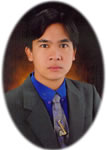 |
pelinks4u editor:
Mr. Bienvenido Batallones Constantino, Jr.
Professor, University of Baguio
General Luna Road, Baguio City, Philippines |
Palawan is considered
the longest and biggest island province
in the western part of the country, and
some of its parts are still uninhabited.
It is an hour by air and 24-27 hours by
sea from the capital of the Philippines,
Manila. It is considered a remote province,
but one that is rich in natural resources.
Palawan National School
(PNS) is the biggest public high school
in the province with more than 6000 high
school students coming from different and
remote areas of the province. This is where
I graduated, and there has been no great
change in the physical education program
in the 15 years since then. |
I can clearly remember when my friend called
me with the news that Palawan National School's
grandstand, the only building intended for the
Physical Education Program, was burned. This
was the only building with the classrooms needed
for the thousands of students taking physical
education. The ruined bleacher on the left wing
of the grandstand served as an extension for
PE classes as well. I was in my first year of
high school (1989) when the grandstand was renovated;
when I came back to teach it was falling apart
so it only took a single match stick to burn
and destroy it.
|
The grandstand was composed of 10 classrooms
that accommodated more than 60 students
each. Chairs were not enough to accommodate
the students inside; there were some who
had to stand for the whole hour of discussion.
You had to come early if you wanted to
sit!
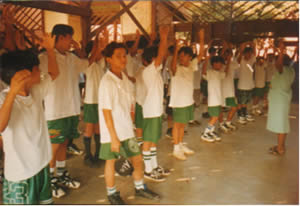 |
Students
having their PE classes under the
25-year old wooden grandstand with
their teacher Mrs.Estring Lerio |
|
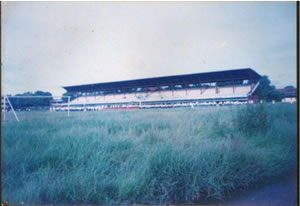
The
old PNS grandstand stood in the midst of
tall grasses and served as the oldest facility
in PE |
Palawan National School (PNS) is a public high
school run by the government's Department of
Education (DepEd). The school is financially
dependent on the local government of the city
of Puerto Princesa, the capital of the province.
Public schools in this province offer different
PE programs. Private secondary schools usually
offer advanced PE classes because they have
complete "state of the art" facilities
for their PE programs. However, both are under
the authority of the DepEd. Public high schools
in the province, particularly PNS, are not lucky
enough to have facilities or equipment for high
school PE students due to the limited budget
provided by the DepEd and the city government.
Instead, the DepEd is responsible for choosing
and hiring the best PE teacher for PNS and other
public schools in the province.
PE
teachers in PNS are carefully screened
and chosen by the management of PNS. They
are all skilled teachers and mostly former
athletes who successfully finished their
respective degrees. PE teachers are highly
competitive professionals. Despite the
program lacking funds, they strive to
provide students with what they deserve.
Even in the midst of many struggles, they
have found ways to make the PE program
possible in the institution.
Teachers are not only skilled in PE,
but also capable of teaching music and
arts because the PE program is integrated
with music and arts and is called PEHM
(Physical Education, Health and Music).
At present, PE is also integrated with
another subject called MAKABAYAN,
a new provision implemented by the DepEd
under former Education secretary and former
Philippine Senator Raul Roco. |
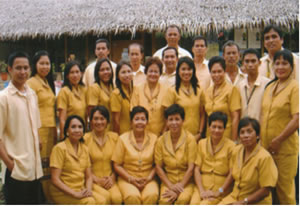
Competitive
teachers of PE program of Palawan National
School in Palawan, Philippines |
| Mr.
Apdon, a world-class trainer rand coach
in Sepak Takraw, teaching his gymnastic
class, while students at the right wait
for their turn while comfortably sitting
on a dangerous gutter of the grandstand
that was almost ruined. |
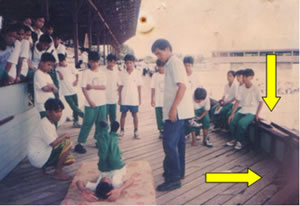 |
I
can attest that even during my time in
PNS, 1989-1993, the skills and knowledge
of the PE teachers were incomparable.
They were equipped with enough skills
and knowledge, but not with the facilities
that they needed to teach PE. Most of
the teachers are former athletes who excelled
in their field and had excellent academic
achievement during college days.
Elma Arquero
(group picture above, 4th from the left,
second row) and Roel
Pocallan (3rd from the left, 3rd
row among the groups males teachers) are
my classmates now, and both teach secondary
PE. They both used to be national athletes
in Athletics and tae-kwon-do. They have
dedicated their lives to mastering their
field so they can become an efficient
mentor for thousands of students who expect
to learn about fitness and sports. These
are just two of the competitive PE teachers
in Palawan National School. |
Yet, being effective
is difficult in the absence of proper facilities.
Teachers have trained in countless national
seminar-workshops to use facilities and equipment
in their own field of choice. However, when
returning to their respective class there is
no equipment for use. More than 6000 students
suffered in their PE classes every year in this
school due to the absence of facilities and
equipment for sports programs.
PE
students have not seen a single apparatus
for gymnastics or water sports, even though
this province is surrounded by water.
Some students only learn about equipment
and facilities by seeing pictures their
teacher provides. These are the lucky
ones, because others have teachers that
can only describe the equipment based
on their imagination and from experience
in seminars. Most of students fail to
enjoy PE programs due to the absence of
apparatus and limited facilities. Frequently,
the PE program described in books cannot
be followed because of this problem. At
most it can only be discussed and explained
by PE teachers.
It has been, and continues to be a dilemma
every year. This problem is common in
almost all public high schools all-over
the country. However, for dance classes
music and practice places are not a problem
in PNS. PNS is blessed with a spacious
field intended for dance classes, and
this is what the students enjoy. |
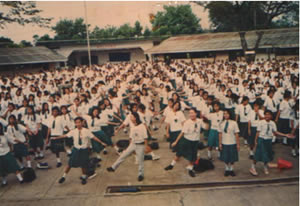
Students
of PNS participate in morning exercises
after the flag ceremony. |
Some of the PE programs
being introduced for the students of PNS are:
- Philippine and foreign folkdances
- Aerobics
- Ball games
- Basketball
- Volleyball
- Baseball and softball
- Table tennis
- Sepak Takraw/Sipa
- Football
- Gymnastics
- Athletics
- Combative sports
- Mass Demonstration
- Larong Bayan (Philippine Indigenous Sports)
- Badminton
Some of the
many factors why students fail to appreciate
Physical Education
ENVIRONMENTAL FACTORS
1) No equipment and limited facilities for
students
Try to imagine a gymnastic class with 2000
students and no apparatus available! How can
the teacher demonstrate a simple balance beam
walk? Or simply show an uneven bar? Basketball
and volleyball classes have the best privileges
because the students love to play these games,
eagerly bring their own equipment, and there
is a facility for these sports. Baseball class
uses balls made of stockings and pieces of wood
for bats to avoid injuries. Good for track and
field class because PNS has its own track oval.
(But I felt so sorry for field events because
there is no equipment available; it is just
too expensive to provide for classes of more
than 60 students each!). I remember that we
were the last batch to use the ruined Javelin
spear 15 years ago!
2) There are not sufficient classrooms for
PE classes
A classroom is necessary for PE teachers during
discussions. Some of the places teachers hold
their classes are open fields, in the corridors,
under the trees, or in ruined or abandoned classrooms.
It's unimaginable for a big PE class to be in
an open field where different distractions occur.
This environment is not conducive for learning.
PE demands a healthy environment where students
can play in safety. Classrooms continue to be
a big problem in Philippine education. The government
is striving to provide better classrooms for
new batches of students, but funding for education
is insufficient for the 85 million Filipinos.
Some need to rely on donations from private
entities.
STUDENT FACTORS
1) Overloading the number of students inside
the classroom
Overloading of students in the PE classrooms
has been a problem for every PE class. Teachers
cannot refuse students' enrollment in their
PE class because it is a public school. This
is the same problem for all public PE teachers
all over the Philippines. In an overloaded PE
class, students who are standing are not interested
in listening during discussion because of individual
concerns and the unhealthy environment. This
is why some PE teachers hold their classes in
open fields, but then other distractions reduce
the student's attention to the teacher. Overloading
often leads to the students ignoring their PE
classes. Not even motivations have been able
to increase their appreciation of PE.
2) Lack of interest and skills due to poor
health status
PNS is a public high school; thus, students
are over-flowing in each class. Not all are
able to perform their PE activities properly
because some are "weaklings." Teachers
measure students' skills in PNS through a Physical
Fitness Test (PFT). The PFT is given before
a proper PE program is provided. Poor health
status is still a problem in public schools
in the country because most of students in public
schools are the poorest of poor. A simple medical
slip from a doctor stating that a student is
weak is enough to exempt them from their PE
classes for the entire year or even their entire
stay in high school.
TEACHER FACTOR
1) Lack of skilled teachers due to the lack
of funding
In Palawan National School teachers have been
trained to "teach and execute." But
the efficiency declined when teachers were given
too many loads. Each teacher is handling at
least 7-10 different PE classes from first year
to fourth year. This is about 350-500 students
for each teacher! Quality PE has been sacrificed
to accommodate all the students. Due to very
limited funds, the DepEd cannot hire new PE
teachers. There are hundreds waiting for vacancies
and opportunities, but because of the DepEd's
financial problem, some of these teachers decided
to work abroad expecting a better life. Moreover,
the government has a good program for teachers
who are domestic helpers and who plan on coming
back to teach in the Philippines. They will
have an immediate slot in public schools at
either the elementary or secondary level. This
is an attempt of Gloria's government to improve
quality of education in the country.
Despite these dilemmas, PNS still produces
the best athletes from their PE classes. Most
of the athletes being trained to compete in
nationals were discovered in PE classes. Thousand
of athletes that have competed in different
national games were produced by quality PE teachers
in PNS. World-class athletes in Sepak
Takraw have been produced and trained
at PNS. It's an irony to think that despite
this opportunity PNS is still far behind in
comparison to other schools in the Philippines
and even farther behind other countries in the
South East Asian region.
The local government of Puerto Princesa has
devised a plan to solve the problem of public
schools, along with the private entities. PE
teachers are led by their head Mrs. Flor Alfonso
and the PNS administration. They are all working
and striving together to provide the best for
young generations to come.
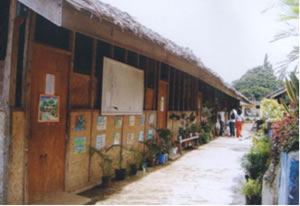 |
|
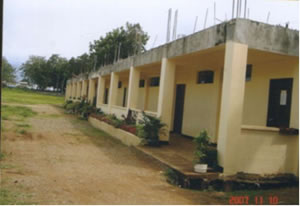 |
| The
improvised classrooms through the collaborative
efforts of the PNS administration after
the burning of the old grandstand |
|
The
site of the old burned grandstand has been
replaced with new PE classrooms through
the effort of the city government of Puerto
Princesa and lead by Mayor Edward Hagedorn. |
(pelinks4u
home) |



